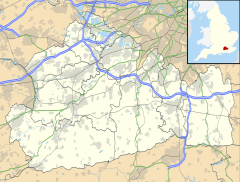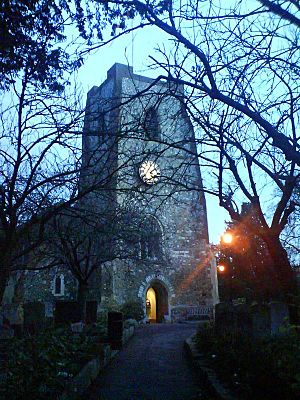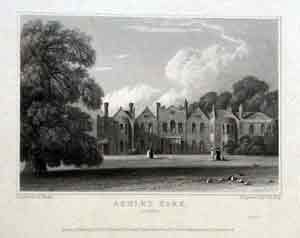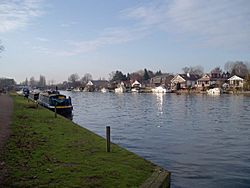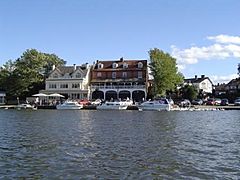Walton-on-Thames facts for kids
Quick facts for kids Walton-on-Thames
|
|
|---|---|
 Walton Bridge |
|
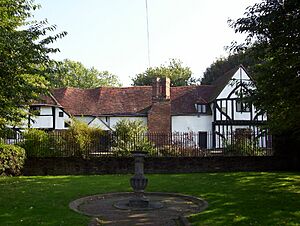 The Old Manor House, Walton-on-Thames |
|
| Area | 9.66 km2 (3.73 sq mi) |
| Population | 22,834 (2011 Census) |
| • Density | 2,364/km2 (6,120/sq mi) |
| OS grid reference | TQ103663 |
| Civil parish |
|
| District |
|
| Shire county | |
| Region | |
| Country | England |
| Sovereign state | United Kingdom |
| Post town | WALTON-ON-THAMES |
| Postcode district | KT12 |
| Dialling code | 01932 |
| Police | Surrey |
| Fire | Surrey |
| Ambulance | South East Coast |
| EU Parliament | South East England |
| UK Parliament |
|
Walton-on-Thames, often called Walton by locals, is a town in northwest Surrey, England. It sits on the south side of the River Thames. The town is part of the Borough of Elmbridge and is about 15 kilometers (9 miles) southwest of central London.
Walton is a busy town with many transport options. In 2011, about 22,834 people lived there. Most of Walton has suburban streets, but its town center is very old, dating back to Celtic times. It is one of the biggest towns in Elmbridge, along with Weybridge.
Contents
History of Walton-on-Thames
The name "Walton" comes from an old Anglo-Saxon word. It means "Briton settlement" or "Welsh Town." Before the Romans and Saxons, Celtic people lived here. The word "Wealas" was used for these Celtic people, meaning "foreigners."
Some people believe that Julius Caesar crossed the River Thames near Walton during his second invasion of Britain. This spot is called Cowey Stakes. Old stories say that wooden stakes were found in the river, which might have been used to stop Caesar's army. However, there isn't strong proof of this today.
Walton was part of an Anglo-Saxon area called Elmbridge Hundred. It was mentioned in the Domesday Book in 1086. This book was a big survey of England ordered by William the Conqueror. It showed that Walton had a church, two mills, a fishery, and many farms.
The oldest part of the village is in the north. Later, the town grew around the Walton-on-Thames railway station. St. Mary's Parish Church is very old, with parts from the Saxon period and the 12th century. It has a bell tower with eight bells, the oldest from 1606. The church also has a strange old item called a "scold's bridle," which was used in the 17th century.
Henry VIII built a royal palace called Oatlands about a mile upstream in 1538.
In the 17th century, John Bradshaw lived in a Tudor manor house in Walton. He was the judge who oversaw the trial of King Charles I.
Walton during the World Wars
During World War I, soldiers from New Zealand were treated at Mount Felix House in Walton. There is a memorial in the cemetery for those who died there. You can also find memorials in St Mary's Church and on New Zealand Avenue.
In World War II, Walton was bombed several times by German planes. This was because important aircraft factories were nearby in Brooklands. On September 27, 1940, a fighter pilot named F/Sgt. Charles Sydney died when his plane crashed in Station Avenue. A plaque marks the spot where he crashed.
Early Businesses and Sports
In the early 1950s, a company called Hersham and Walton Motors (HWM) built its own racing cars. Famous driver Stirling Moss raced in his first Formula One Grand Prix in an HWM car. HWM was also the first dealership for Aston Martin cars.
Walton used to have a golf club called Ashley Park Golf Club, which opened in the 1890s.
Town Life and Shopping
Walton-on-Thames is part of a larger built-up area that includes nearby towns like Hersham and Shepperton. This area has a population of about 66,566 people.
The town center of Walton has been redeveloped and is now called "The Heart of Walton." It has a shopping mall with many popular stores like Next and Waterstone's. The public library also moved here. There are also many restaurants, including Nando's and Pizza Express.
Around the edges of the town, you'll find businesses related to cars, construction, and gardening. Near Walton station, there are office buildings, including the headquarters for Kia Motors. A new Walton Bridge was also finished in 2013.
Getting Around Walton
Walton-on-Thames has its own Walton-on-Thames railway station. Trains run to London Waterloo four times an hour. Some trains are fast and can reach London in just 25 minutes. This train service has helped Walton grow a lot. For example, its population more than quadrupled between 1851 and 1911.
There are also regular bus services that connect Walton to nearby towns like Weybridge, Shepperton, and Kingston-upon-Thames. You can also take a boat trip on the river around Desborough Island. Taxis are available at the train station.
Walton Bridge
Six different bridges have crossed the River Thames from Walton to Shepperton. Before the first bridge, people used a ferry to cross the river.
The first bridge was made of wood and built between 1748 and 1750. It lasted until 1783. A famous painter named Canaletto painted this bridge in 1754.
The second bridge was built in 1788 from brick and stone. It lasted much longer, until 1859. J. M. W. Turner painted this bridge in 1805.
After the second bridge fell, a ferry was used again until the third bridge was built in 1864. This one was a metal girder bridge on stone supports. A brick viaduct (a long bridge-like structure) was also built to cross the flood plain, and it is still standing today.
During World War II in 1940, the third bridge was damaged. A fourth temporary bridge was built in 1953. This bridge was later used only by bikes and walkers.
In 1999, a fifth temporary bridge replaced the fourth one. This bridge had some problems at first.
Building a sixth bridge started in 2011 and finished in 2013. It opened to traffic on July 22. This new bridge cost £32.4 million. It is special because it has no supports in the river, which makes it easier for boats to pass. It is also the only curved tied-arch bridge without piers on the River Thames.
Sports and Activities
The Elmbridge Xcel Leisure Centre is in the east of Walton, near the Thames. It has two swimming pools, a large gym, indoor courts, and a climbing wall.
The River Thames is great for water sports. You can go rowing, canoeing, kayaking, or punting. The Walton Rowing Club and Thames Valley Skiff Club are located along the river.
Walton Athletics Club started in 1942. It has about 200 members, from 9-year-olds to people over 60. The club offers coaching in many athletics sports like track and field and cross country.
Walton-on-Thames Cricket Club plays in Ashley Park. They have several teams and have had players who went on to play for bigger teams.
Walton has two football clubs: Walton Casuals and Walton & Hersham. Walton Casuals are nicknamed the Stags and play in orange and black. Walton & Hersham are called the Swans and play in red and white. In 1973, Walton & Hersham won the FA Amateur Cup and later beat a professional team, Brighton & Hove Albion, in the FA Cup.
Famous People from Walton
Many interesting people were born in or have lived in Walton-on-Thames:
- Julie Andrews, a famous actress, singer, and author, was born here in 1935.
- Matthew Brittin, who works for Google, is from Walton.
- George Brydges Rodney, a Royal Navy Admiral, was born in 1718.
- Natascha McElhone, an actress, was born here in 1971.
- Nick Lowe, a singer-songwriter and musician, was born in 1949.
- Ian Rank-Broadley, a sculptor who designed British coins, was born in 1952.
- Anthony Watson, an England International Rugby Union player, is from Walton.
- Madeleine Albright, who was a US Secretary of State, lived in Walton during World War II.
- Fay Ripley, an actress, grew up in Walton.
Walton in Film and TV
Walton-on-Thames has been a filming location for several shows and movies:
- Some sketches for the comedy show Monty Python were filmed in Walton. You could even see Walton Town Hall in one sketch.
- The movie Psychomania (1973) filmed scenes in Walton's town center.
- The TV show Is It Legal? was filmed in Walton.
- The Adventures of Robin Hood was filmed at Nettlefold Studios in Walton.
- The BBC sitcom Not Going Out has shown aerial views of Walton-on-Thames.
The Walton Hop
The Walton Hop was a popular teen disco that started in 1958 and ran until 1990. It is believed to be the first public disco in the UK. Many young people from the area enjoyed going there. Musician Luke Haines, who was born in Walton, even released a song called "The Walton Hop" in 2006.
Images for kids
See also
 In Spanish: Walton-on-Thames para niños
In Spanish: Walton-on-Thames para niños


